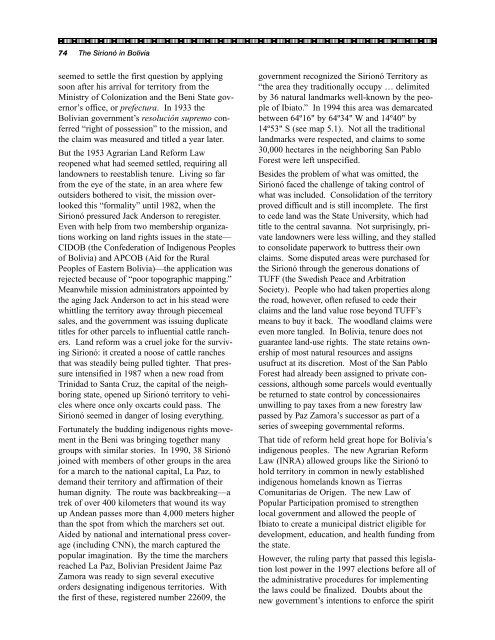Indigenous Peoples and Conservation Organizations
Indigenous Peoples and Conservation Organizations
Indigenous Peoples and Conservation Organizations
You also want an ePaper? Increase the reach of your titles
YUMPU automatically turns print PDFs into web optimized ePapers that Google loves.
74 The Sirionó in Bolivia<br />
seemed to settle the first question by applying<br />
soon after his arrival for territory from the<br />
Ministry of Colonization <strong>and</strong> the Beni State governor’s<br />
office, or prefectura. In 1933 the<br />
Bolivian government’s resolución supremo conferred<br />
“right of possession” to the mission, <strong>and</strong><br />
the claim was measured <strong>and</strong> titled a year later.<br />
But the 1953 Agrarian L<strong>and</strong> Reform Law<br />
reopened what had seemed settled, requiring all<br />
l<strong>and</strong>owners to reestablish tenure. Living so far<br />
from the eye of the state, in an area where few<br />
outsiders bothered to visit, the mission overlooked<br />
this “formality” until 1982, when the<br />
Sirionó pressured Jack Anderson to reregister.<br />
Even with help from two membership organizations<br />
working on l<strong>and</strong> rights issues in the state—<br />
CIDOB (the Confederation of <strong>Indigenous</strong> <strong>Peoples</strong><br />
of Bolivia) <strong>and</strong> APCOB (Aid for the Rural<br />
<strong>Peoples</strong> of Eastern Bolivia)—the application was<br />
rejected because of “poor topographic mapping.”<br />
Meanwhile mission administrators appointed by<br />
the aging Jack Anderson to act in his stead were<br />
whittling the territory away through piecemeal<br />
sales, <strong>and</strong> the government was issuing duplicate<br />
titles for other parcels to influential cattle ranchers.<br />
L<strong>and</strong> reform was a cruel joke for the surviving<br />
Sirionó: it created a noose of cattle ranches<br />
that was steadily being pulled tighter. That pressure<br />
intensified in 1987 when a new road from<br />
Trinidad to Santa Cruz, the capital of the neighboring<br />
state, opened up Sirionó territory to vehicles<br />
where once only oxcarts could pass. The<br />
Sirionó seemed in danger of losing everything.<br />
Fortunately the budding indigenous rights movement<br />
in the Beni was bringing together many<br />
groups with similar stories. In 1990, 38 Sirionó<br />
joined with members of other groups in the area<br />
for a march to the national capital, La Paz, to<br />
dem<strong>and</strong> their territory <strong>and</strong> affirmation of their<br />
human dignity. The route was backbreaking—a<br />
trek of over 400 kilometers that wound its way<br />
up Andean passes more than 4,000 meters higher<br />
than the spot from which the marchers set out.<br />
Aided by national <strong>and</strong> international press coverage<br />
(including CNN), the march captured the<br />
popular imagination. By the time the marchers<br />
reached La Paz, Bolivian President Jaime Paz<br />
Zamora was ready to sign several executive<br />
orders designating indigenous territories. With<br />
the first of these, registered number 22609, the<br />
government recognized the Sirionó Territory as<br />
“the area they traditionally occupy … delimited<br />
by 36 natural l<strong>and</strong>marks well-known by the people<br />
of Ibiato.” In 1994 this area was demarcated<br />
between 64º16" by 64º34" W <strong>and</strong> 14º40" by<br />
14º53" S (see map 5.1). Not all the traditional<br />
l<strong>and</strong>marks were respected, <strong>and</strong> claims to some<br />
30,000 hectares in the neighboring San Pablo<br />
Forest were left unspecified.<br />
Besides the problem of what was omitted, the<br />
Sirionó faced the challenge of taking control of<br />
what was included. Consolidation of the territory<br />
proved difficult <strong>and</strong> is still incomplete. The first<br />
to cede l<strong>and</strong> was the State University, which had<br />
title to the central savanna. Not surprisingly, private<br />
l<strong>and</strong>owners were less willing, <strong>and</strong> they stalled<br />
to consolidate paperwork to buttress their own<br />
claims. Some disputed areas were purchased for<br />
the Sirionó through the generous donations of<br />
TUFF (the Swedish Peace <strong>and</strong> Arbitration<br />
Society). People who had taken properties along<br />
the road, however, often refused to cede their<br />
claims <strong>and</strong> the l<strong>and</strong> value rose beyond TUFF’s<br />
means to buy it back. The woodl<strong>and</strong> claims were<br />
even more tangled. In Bolivia, tenure does not<br />
guarantee l<strong>and</strong>-use rights. The state retains ownership<br />
of most natural resources <strong>and</strong> assigns<br />
usufruct at its discretion. Most of the San Pablo<br />
Forest had already been assigned to private concessions,<br />
although some parcels would eventually<br />
be returned to state control by concessionaires<br />
unwilling to pay taxes from a new forestry law<br />
passed by Paz Zamora’s successor as part of a<br />
series of sweeping governmental reforms.<br />
That tide of reform held great hope for Bolivia’s<br />
indigenous peoples. The new Agrarian Reform<br />
Law (INRA) allowed groups like the Sirionó to<br />
hold territory in common in newly established<br />
indigenous homel<strong>and</strong>s known as Tierras<br />
Comunitarias de Origen. The new Law of<br />
Popular Participation promised to strengthen<br />
local government <strong>and</strong> allowed the people of<br />
Ibiato to create a municipal district eligible for<br />
development, education, <strong>and</strong> health funding from<br />
the state.<br />
However, the ruling party that passed this legislation<br />
lost power in the 1997 elections before all of<br />
the administrative procedures for implementing<br />
the laws could be finalized. Doubts about the<br />
new government’s intentions to enforce the spirit

















